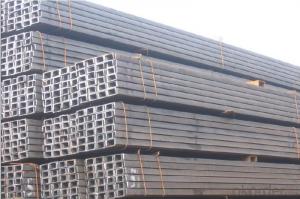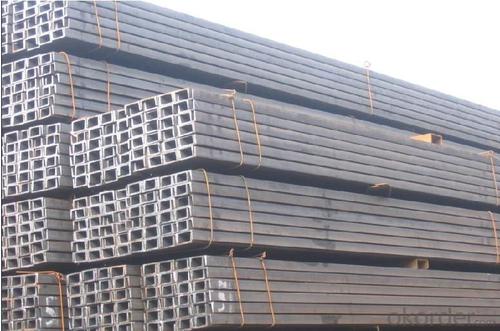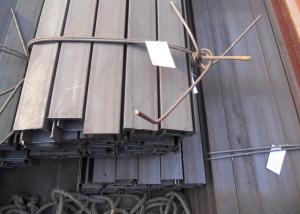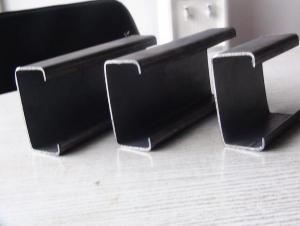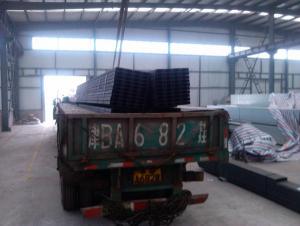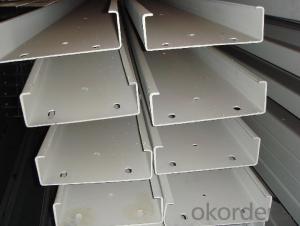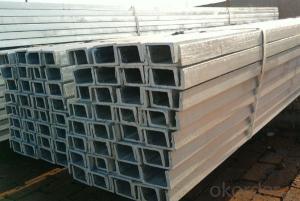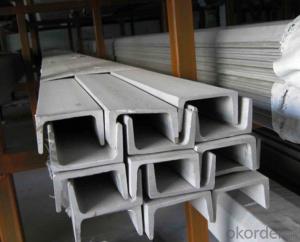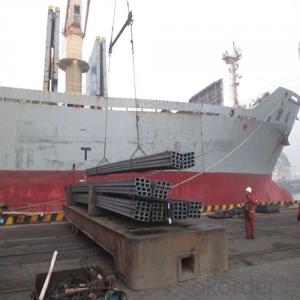GB Standard Steel Channel 50mm-62mm with High Quality
- Loading Port:
- China Main Port
- Payment Terms:
- TT or LC
- Min Order Qty:
- 25 m.t
- Supply Capability:
- 10000 m.t/month
OKorder Service Pledge
OKorder Financial Service
You Might Also Like
Product Description:
Specifications of GB Standard Steel Channel 50mm-62mm with High Quality:
We are definitely specializing in manufacturing and supplying channel steel.
| Standard: | GB/T 6723-86 |
| Sizes: | 50mm to 300mm |
| Sales Volume/Year: | 3000MT |
| Destination Area: | Middle EasAfrica, Southeast Asiat, |
2. Size, Length and Mass of GB Standard Steel Channel 50mm-62mm with High Quality.
| Size(mm) | Length(m) | Mass(Kg/m) |
50*25*2.5 mm | 6m, 12m | 1.444 kg/m |
| 62*44*1.6 mm | 6m, 12m | 1.796 kg/m |
Package & Delivery of GB Standard Steel Channel 50mm-62mm with High Quality:
The steel u channel will be packed in bundle with steel wire at each end of every bundle and color marking in order to help the customer to recognize his goods more easily at sight.
And steel u channel could be loaded into 20ft or 40ft container, or by bulk cargo. If the weight of each bundle reaches less than 3.5 mt, the loading by break bulk cargo should be choosed. When the weight of each bundle reaches less than 3mt, the loading by container should be choosed.
As for the transportaion from mill to loading port, the truck will be usually used. And the maximum quantity for each truck is 40mt.
All in all, we could do in accordance with customer's request.
FAQ:
Q1: How soon can we receive the product after purchasement?
A1: Within three days of placing an order, we will begin production. The specific shipping date is dependent upon international and government factors, but is typically one month.
Q2: How do you guarantee the quality of our products?
A2: We have established an advanced quality management system which conducts strict quality tests at every step, from raw materials to the final product. At the same time, we provide extensive follow-up service assurances as required.
Q3: The prices are invoicing on theoritical weight or on actual weight?
A3: We can do it in both manners, according to the customers' request.
Images of GB Standard Steel Channel 50mm-62mm with High Quality:
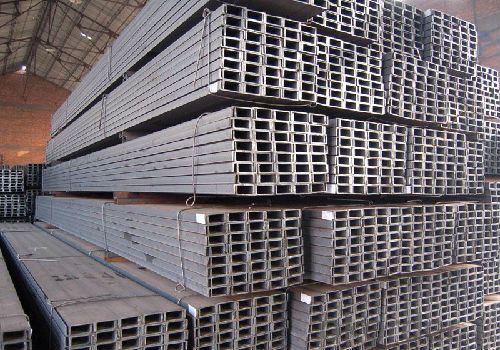
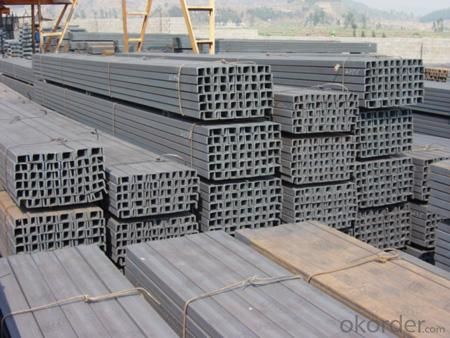
If you would like to get our price, please inform us the standard/material, size and quantity. Thank you very much.
- Q: How do steel channels contribute to sustainable construction practices?
- Steel channels contribute to sustainable construction practices in several ways. Firstly, steel is a highly durable and long-lasting material, which means that structures made with steel channels have a longer lifespan, reducing the need for frequent repairs or replacements. Additionally, steel channels are often made from recycled steel, which helps to conserve natural resources and reduce the environmental impact of mining and processing new materials. Moreover, steel is a highly recyclable material, meaning that at the end of a structure's life, the steel channels can be easily recycled and used in new construction projects, reducing waste and promoting a circular economy. Lastly, steel channels provide strength and stability to structures, allowing for efficient designs that require fewer materials, resulting in reduced energy consumption during construction and lower carbon emissions. Overall, the use of steel channels in construction helps to achieve sustainability goals by promoting durability, resource conservation, waste reduction, and energy efficiency.
- Q: How do steel channels contribute to the overall stability of a structure?
- Steel channels contribute to the overall stability of a structure by providing structural support and reinforcement. They are often used as beams or columns, distributing the load and transferring it to the foundation or other supporting elements. Their shape and material properties enhance their strength and stiffness, allowing them to withstand bending, torsion, and other forces that can cause structural instability. Additionally, steel channels can be strategically placed to resist lateral movements and vibrations, ensuring the stability and integrity of the entire structure.
- Q: What are the lengths of the channel factory?
- Channel steel is a kind of carbon structural steel used for construction and machinery. It is a complex section steel. Its cross section has a groove shape. Channel steel is mainly used in building structure, curtain wall engineering, mechanical equipment and vehicle manufacturing, etc..
- Q: What are the common design codes and standards for steel channels?
- Steel channels must adhere to various design codes and standards to guarantee their structural integrity and safety. The most widely recognized codes and standards for steel channel design include: 1. The AISC (American Institute of Steel Construction) Steel Construction Manual provides specifications for the design, fabrication, and erection of structural steel for buildings. It offers guidelines for steel channel design, covering dimensions, loading conditions, and connection requirements. 2. The ASCE (American Society of Civil Engineers) publishes standards and guidelines for civil engineering structures, including steel channels. Their publication ASCE 7-16 Minimum Design Loads and Associated Criteria for Buildings and Other Structures specifies the loads and load combinations that steel channels should withstand. 3. The IBC (International Building Code) is a comprehensive set of building regulations adopted globally. It includes provisions for the design of steel channels and other structural elements, emphasizing safety, load resistance, and structural stability. 4. The EN (European Committee for Standardization) standards define specifications for various steel products, including channels. EN 10025-2 specifically covers hot-rolled structural steel channels, outlining their mechanical properties, dimensions, and tolerances. 5. The BSI (British Standards Institution) publishes standards for steel channels under the BS EN 10365 series. These standards address dimensions, tolerances, and technical requirements for hot-rolled steel channels used in construction. Designers, engineers, and manufacturers must comply with these codes and standards to ensure proper design, fabrication, and safe usage of steel channels in diverse structural applications. Adhering to these guidelines promotes consistency, quality, and structural integrity within the construction industry.
- Q: Can steel channels be used in solar panel installations?
- Yes, steel channels can be used in solar panel installations. Steel channels, also known as steel C channels or steel U channels, are commonly used in construction and industrial applications for their strength, durability, and versatility. When it comes to solar panel installations, steel channels can be used as support structures for mounting solar panels on rooftops or in ground-mounted systems. Steel channels provide a stable and robust framework that can withstand the weight of solar panels and withstand various weather conditions. They can be easily customized and fabricated to meet specific installation requirements, such as the size and angle of the solar panels. Additionally, steel channels can be galvanized or coated to provide corrosion resistance, ensuring the longevity of the solar panel installation. Furthermore, steel channels offer flexibility in terms of design and layout. They can be easily integrated with other mounting systems and components, such as rails, brackets, and clamps, allowing for efficient and secure solar panel installations. The adaptability of steel channels makes them suitable for both residential and commercial solar panel projects. In conclusion, steel channels are a viable option for solar panel installations due to their strength, durability, versatility, and compatibility with other mounting systems. They provide a solid foundation for mounting solar panels, ensuring a stable and efficient solar energy system.
- Q: According to the standard, indoor hanging stone 3 meters high, whether to add channel?
- Dry hanging method of stone, also called hollow hanging method. "Stone hanging tools for special purposes, construction basket rental sales" is the current wall decoration in a new type of construction process. The method uses a metal pendant to hang the facing stone directly on the wall surface or hollow over the steel frame, without grouting and pasting. The principle is in the main structure is arranged on the main points, the metal Guajian stone will be fixed on the building, forming a decorative stone curtain wall.
- Q: How do steel channels contribute to the overall durability of a railway bridge?
- Steel channels contribute to the overall durability of a railway bridge by providing structural support and reinforcement. These channels are designed to bear heavy loads and distribute them evenly, preventing any localized stress that could weaken the bridge. Additionally, the high strength and corrosion resistance of steel channels ensure that the bridge can withstand harsh environmental conditions, such as extreme temperatures and moisture, without compromising its integrity.
- Q: How do steel channels contribute to the overall acoustics of a building?
- Steel channels can contribute to the overall acoustics of a building by reducing sound transmission and enhancing sound insulation. The use of steel channels helps in isolating noise between different areas within a building, preventing unwanted sound from traveling through walls and floors. Additionally, they can help in improving the overall sound quality within a space by reducing echoes and reverberation, creating a more pleasant and controlled acoustic environment.
- Q: Are steel channels suitable for use in broadcasting towers?
- Yes, steel channels are suitable for use in broadcasting towers. Steel channels are commonly used in construction due to their strength and durability. Broadcasting towers require materials that can support the weight of the antennas and withstand various weather conditions, including strong winds and seismic activity. Steel channels are capable of providing the necessary structural integrity and stability required for broadcasting towers. Additionally, steel channels can be easily fabricated and assembled, which makes them a cost-effective choice for constructing tall structures like broadcasting towers.
- Q: How do steel channels perform under seismic loads?
- Steel channels are known for their excellent performance under seismic loads. The inherent strength and ductility of steel, combined with the structural characteristics of channels, make them highly resilient to seismic forces. Steel channels can effectively absorb and distribute the energy generated during an earthquake, reducing the potential for structural damage or collapse. Additionally, steel channels can be designed and reinforced with appropriate connections and bracing to enhance their seismic performance, ensuring the safety and stability of structures in earthquake-prone areas.
Send your message to us
GB Standard Steel Channel 50mm-62mm with High Quality
- Loading Port:
- China Main Port
- Payment Terms:
- TT or LC
- Min Order Qty:
- 25 m.t
- Supply Capability:
- 10000 m.t/month
OKorder Service Pledge
OKorder Financial Service
Similar products
Hot products
Hot Searches
Related keywords
